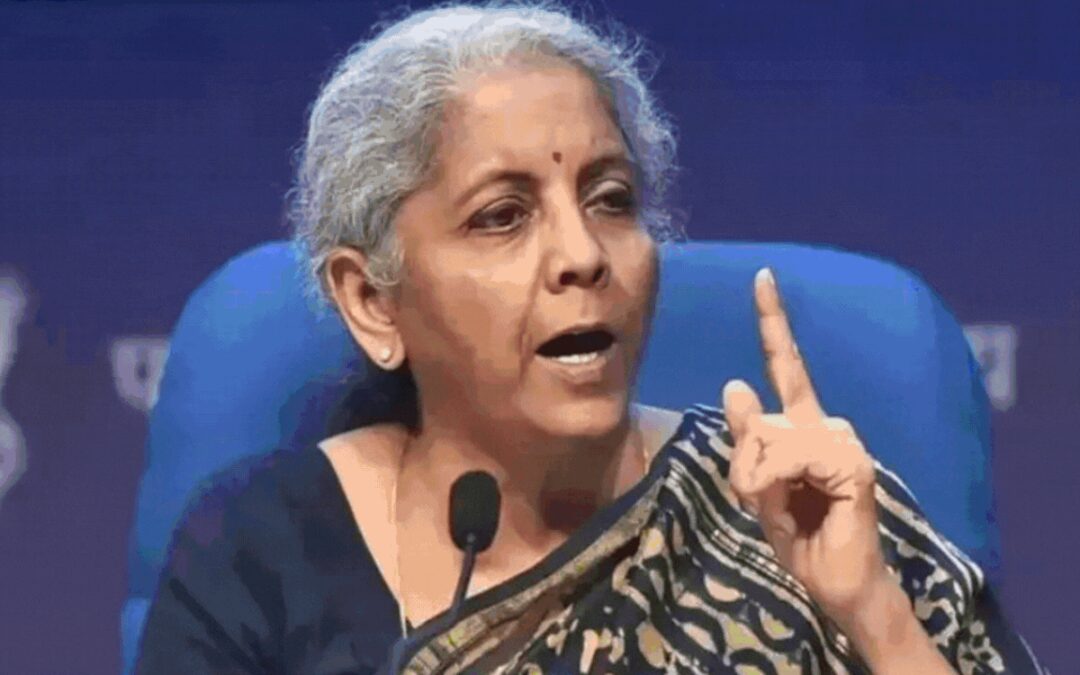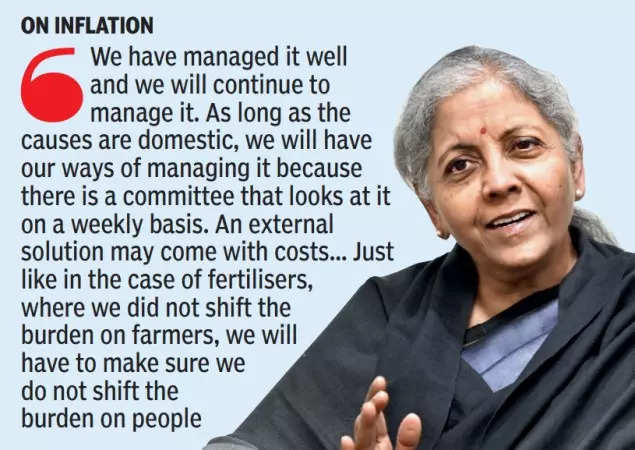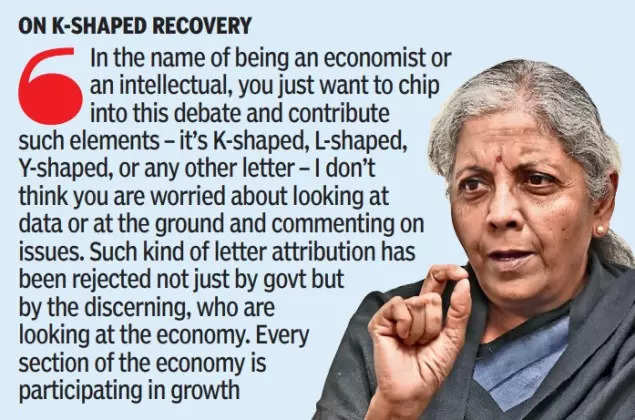Finance minister Nirmala Sitharaman has been leading the Modi government’s economic management in the second term. In a detailed interview after presenting her sixth straight budget, she spoke to TOI on a wide range of issues, and said that govt held its hand while presenting the vote on account as it did not want to address issues in patches and, hence, opted to wait for the full budget in July. The FM is confident that the Indian economy is on course to retain the growth momentum and govt will be able to keep inflation under check. Excerpts:
You have faced turbulent years as FM due to the pandemic and other issues. How do you look back at the last few years? Do you see this as the best year during your term?
After Covid, the economy has been showing its inherent strength, resulting in investment, mergers and acquisitions, and recovery of small businesses. I must appreciate that MSMEs have used the liquidity facility given to them quite wisely and sparingly. The economy has shown the thirst to come out of the problem completely and show its true potential. I completely credit the people and the drive they have shown. Otherwise, it was not possible to grow faster and faster and remain in the top slot in the world.
Five years ago, PM-Kisan and tax concessions were part of the Interim Budget. This time, there has been a lot of restraint and you have kept the vote on account simple. Is it because you are more confident of government getting a third term?
If you have observed PM (Narendra Modi) as CM, he has consistently been on the side of prudent economic management. In Gujarat, that was the signature. As much as he would invite global investors and as much as he would go and sit with farmers and attend to every section – from animal husbandry to dealing with water issues -he was always clear on how finances should be managed optimally. So, the tendency to keep public accounts clean, transparent and exercise prudence without sacrificing social welfare and projects critical for inclusive growth, has always been there. Right at the beginning I got the guidance– maintain transparency, keep everything on the books – and this is just a vote on account.There was room to enhance revenue spending and still stay on the fiscal glide path. What is the reason for not taking advantage of it?
This budget is not the opportune time to do it, a comprehensive budget, which will come in July, is where we should think of all this. One patchy announcement here can limit the scope of what you can do in July. A comprehensive approach should be taken in July rather than now.
What is the reason for restricting the mandate of the Finance Commission to giving only what is provided in the Constitution?
We want to make sure that those authorities should be able to take a comprehensive look at what is the business and take a call and recommend, keeping the larger interest in mind. We do not need to tailor things narrowly. It is for them to decide what is in the best interests of India at a time when it is growing fast in post-Covid times and amid the challenging global environment.
The budget creates space for the private sector to start the investment cycle. Does it also create space for lower interest rates and how confident are you that private sector will finally begin to invest?
That’s a totally different kettle of fish. It’s entirely the assessment of the monetary policy committee to see where the economy is and what they want to do. I don’t think there is a link to the budget.
There are certain segments such as cement where private investment has begun to flow, but others have lagged. There is a long waiting list for cars partly because of capacity issues– what is the feedback from industry on investment?
You are only looking at what are the old, traditional sectors. Investment is happening in new sunrise domains. Look at the interest which industry has shown in green ammonia, in batteries, green hydrogen, in bringing AI. Look at the way solar is growing or the way the ancillary activity in the space sector is happening. There is investment in materials research. People are looking at different countries to see where they should go to tap a particular material. So, it’s not as if the private sector is not coming on board. We are refusing to see those areas where they are coming on board, we are only looking at cement and steel.
You have announced a mega innovation fund. How will it work and which will be the focus sectors?
Relevant departments will work out the details. The idea is to place Rs 1 lakh crore over the next few years as a corpus – the amount will be given interest-free for 50 years. An agency will then run it professionally and identify innovation-related activities in the private domain.
How do you see these interest-free loans as instruments that are helping you achieve desired goals like power sector reforms. If you could give us a sense of the areas where you want the states to reform further?
Even areas where we have commenced, reforms will have to run their full course. Some states have taken to it enthusiastically, some came in later. It will take time because you can only nudge states, you can’t compel them to do things. But when some states see others that have used it moving forward and getting positively impacted, they automatically come on board. It does take a lot of effort beyond announcements, it requires a lot of engagement with states, which is what we are doing. It helps remove doubts to bring them on board.
On disinvestment and privatisation, there seems to be a change in strategy in the sense that now you are focused more on creating value for PSU stocks?
That’s not a change of strategy. It’s our duty to do it and we will do it. We can’t allow our companies to languish because we have not privatised them. In the meanwhile, the loss of value is not going to help them or help us.
What happens to the wider public sector policy that was announced?
It is all consistent with that. Very much in line with it.
A committee has been announced to examine population-related issues and in the post-budget press conference, you said it is going to look into the entire gamut of issues. The Uttarakhand govt has since come out with the Uniform Civil Code (UCC) draft, with population control as one of the focus areas. Is that one of the main drivers for the committee?
The Uttarakhand govt coming out with a UCC has long been talked about. The terms of reference, when issued by home ministry, will have the details of the committee. Home ministry is working with law ministry. But as I said at the press conference, the long-term planning about how we are going to leverage our demographic strengths, and where the challenges lie, the strategy to handle it, are all the matters which have to be looked at and thought through.
There are concerns on irregularities in implementation of MNREGA and CAG has flagged certain issues. Are you planning corrections in the design?
What can you correct if there are some people at the state level who are gaming the system? That’s not going to help. Some states do not want to make the corrections and instead want us to overlook the malpractices. It is a moral question -there are states which are using it honestly and use it for benefit of the people.
In your budget speech you spoke of east India. The gap between east India and the rest of the country has widened to the extent that it has generated a grievance in the south of India that they are having to subsidise the eastern region, especially when they have failed to control their population. How do you see this?
The debate is unhealthy. India needs to grow and every of part of India needs to grow, we cannot have this divisive argument. No one can demand any share linked to what they are contributing.
This argument is inherently contradictory. Even within states, there are pockets which contribute more, and they can’t ask for a bigger share. To push this argument further and maintain that we will form a separate segment if it goes further is not acceptable. Second, as MPs, haven’t people sworn by the Constitution? Every state that speaks in this voice should look within.
Tamil Nadu spoke like this a few months ago. What will happen to rest of Tamil Nadu if Coimbatore region wants to be free, arguing they are contributing more revenue? Or what will happen if Bengaluru de mands as much (returns) as the revenue it contributes to Karnataka?
You have spoken about the beneficiaries of direct benefit transfers and how it had created a new segment of consumers. Is it going to result in higher demand for consumer goods at a time when companies are talking about tepid demand in rural areas?
Just as the media is asking me if capital expenditure growth in outlays is tapering off, some people have asked me about this also. It based on a wrong assumption. In the first case, when we have a low base, 30% growth can take place. But we have now reached Rs 10 lakh crore and on that we are giving a 11% to 14% hike. Does that mean interest is waning?
No. It also depends on how much gets absorbed within the 12 months for which it is given. Similarly, rural areas have got 30 lakh crore of the Rs 34 lakh crore that has been transferred through DBT. People kept it in their accounts and the remaining savings in the bank accounts of Jan Dhan now stands at over Rs 2 lakh crore. Where did the rest of it go? It has gone for consumption. Is that not expenditure consumption? When you saw huge consumption happening post-Covid and the media termed it as revenge buying. Based on that revenge buying, it is not possible that it multiplies three times every year. What kind of economics is this? That will not happen.
How do you react to this constant lament about subdued rural demand. Is it linked to rural distress?
Companies are talking about rural areas looking at different ways of doing business. Rural India is readjusting itself to technology, technology-driven processes, and also wanting to make their own areas their comfort zone, where they can contribute and also earn a living. Schemes such as PM Swanidhi and PM Vishwakarma are helping. With technology, India is bridging the gap for itself. Today rural India is driving India through digital technology which is available for them now. They are selling goods by using technology. People are not assessing this change.
You spoke about previous govts believing in appeasement, while you are seeking to empower everyone. Doesn’t this go against the conventional understanding that if you scatter the goodies across the population then you are not earning the goodwill of anybody?
The analysis that giving everything to everybody doesn’t get you friends, whereas when you do it for some limited people, they will be committed voters, is flawed. As much as it creates a section which is owing their betterment to you and will therefore give you votes, you also create a grudge among others.
PM Modi has taken a stand against differentiating between people. He wants an India where everybody gets the benefit of a pucca house, toilets and drinking water supply at home. It is that thought and BJP’s Antyodaya, to which we are committed, which brought in this approach. The word-of-mouth publicity that everyone is getting the benefit has brought the goodwill. They know that this govt and the PM do what they say.
There is talk of companies moving to Vietnam and Mexico as part of the ‘China+1’ strategy. How is India placed compared to these countries?
We will make every attempt to attract investment. Post-Covid people decided to diversify their supply chains instead of putting all the eggs in one basket to avoid disruptions even if it may have been economically efficient in terms of economies of scale and cost. Now when companies diversify, our attempt to get them here should also keep it in mind that diversification is a consideration for the investors who think of coming. Some ecosystems, in Vietnam and other places, existed even before we moved in. Mexico has seen investments because of its location. We will have to tailor our policies in such a way that we can attract investments despite all this.
We need to be attractive on every score not just on tax concessions and favourable policies, but also other elements. There was an incident on the outskirts of Bengaluru when a contractor did not pay on time, and it had an impact. Workers’ interest needs to be protected at all costs, but the way to go about it has to be different from the socialist era. We need to realise that this is an open economy and we should be cautious on anything that affects our country.
The budget sounds very assured on the inflation side. What gives you that confidence?
We have managed it well and we will continue to manage it. As long as causes are domestic, we will have our ways of managing it because there is a committee that looks at it on a weekly basis. An external solution may come with costs. We will have to import something that is suddenly in short supply.
We may face some logistical issues in some cases even where the source is ready to supply. Just like in the case of fertilisers, where we did not shift the burden on farmers, we will have to make sure we do not shift the burden on people.
We are meeting on a day when the US has struck targets in Iraq and Syria and it will result in fresh uncertainty. Have you factored in this volatility?
External uncertainties have become the order of the day -there was Covid, then chip-related issues, Ukraine war, the Israel-Hamas issue and now the Red Sea issue. We have to be ready for it even when you can’t predict some of these.
What gives you the confidence that the India-Middle East-Europe Economic Corridor is still feasible?
Because of the cost involved in going around the Arabian Peninsula and the dependence on shipping lines. There are options available if land and an alternative sea route become available. A land route with trains on it is the shortest route through the Middle East to Europe. The project has brought in a new dimen sion to connectivity, global trade and countries look at it as an economic opportunity. There may be immediate challenges, but it’s an idea that’s never going to fade. On the contrary, it will gain traction.
Does the situation around the Red Sea warrant any immediate steps from govt in terms of helping exporters meet higher cost or ensuring that supplies are not disrupted?
We will be as much exposed as anybody else. It has multiple dimensions, and it’s a global issue.
Two of India’s most valuable start-ups – Byju’s and Paytm -are facing issues related to corporate governance. Do startups need to relook at the way they do business and conform to rules?
I do not want to comment on issues related to one company. It is for the regulator and the company to deal with each other. Equally, I will not suspect that every company is going through this. The way Indian start-ups have conducted themselves and stood out the world, it’s not for me to advise.

When should we expect the White Paper on economic management? Also, many people had expected a White Paper in 2014 itself, but why did it take so long for you to prepare it?
In 2015-16, PM himself spoke about suggestions of a White Paper and he said that it was not done at that time because it could have shattered the confidence of investors. He left it there. Now we have completed 10 years and when we have brought the economy from Fragile Five to be among the three largest in the world. Now banks are making profits and twin balance sheet problem is a thing of the past. When we have proven that the economy today is on sound ground, what we inherited needs to be known to the public.
India is growing at over 7%. Some critics are saying that it needs to grow at 8-9% and what are your views on this debate on manufacturing versus services?
If we are hoping to grow 7%, there are people who say, we won’t grow at 5%. If we want to push manufacturing in India, we are told we should attend to services because big potential exists. Does that mean we need to forego our traditional strengths in MSMEs? Or does it mean we ignore private entrepreneurship which was stifled in the name of nationalisation.
Even during Covid, when we did not have a template on how to handle the pandemic, we went by inputs on sectors that needed help. We went on evolving policies so that the economy recovers and comes on an even keel. People then advised us to print currency but today they want to see prudence in the budget. Advice and more advice keep coming. We listen to all inputs.
You touched upon the issue of Kshaped recovery recently. Is it really a two-paced growth as some experts are saying, comparing growth in luxury goods with rural sales?
Is the argument hinging on the fact that until they purchase luxury goods in rural areas, they will not accept it’s good growth? In the name of being an economist or an intellectual, you just want to chip into this debate and contribute such elements – it’s K-shaped, L-shaped, Yshaped, or any other letter – I don’t think you are worried about looking at data or at the ground and commenting on issues.
Such kind of letter attribution has been rejected not just by govt but by the discerning, who are looking at the economy. Every section of the economy is participating in growth.
In the initial days, I was told the automobile sector is in deep trouble, they have a large inventory. Today, there is a waiting list even when there is a transition to electric vehicles. I was told banks are sitting on liquidity. Today, it is at a different stage, deposits are growing slower than loans and RBI is working with banks on that. Every issue has been addressed and the effects are showing. I have no problem with a healthy debate, but if I am persisting on an issue without a basis then there is an issue.
Do you think these are independent views or there is a political tinge to it?
I am okay with economists wanting to be politicians and politicians who want authority on economists.














